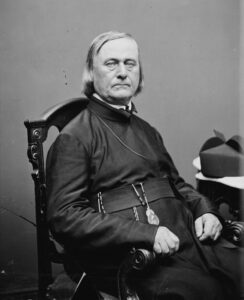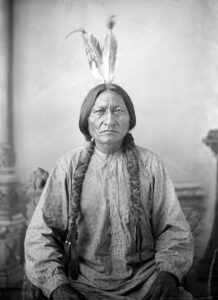 As the United States was being settled, a number of wars were fought between the Native Americans and the White Man. So much anger and so many hard feelings had passed between the two groups that it seemed like peace could never be achieved. Finally, in an attempt to convince local Native Americans to make peace with the United States, the Jesuit missionary Pierre-Jean De Smet met with the Sioux leader Sitting Bull in what is present-day Montana. He saw an urgent need to make peace and decided to go for it.
As the United States was being settled, a number of wars were fought between the Native Americans and the White Man. So much anger and so many hard feelings had passed between the two groups that it seemed like peace could never be achieved. Finally, in an attempt to convince local Native Americans to make peace with the United States, the Jesuit missionary Pierre-Jean De Smet met with the Sioux leader Sitting Bull in what is present-day Montana. He saw an urgent need to make peace and decided to go for it.
De Smet was a native of Belgium, who came to the United States in 1821 at the age of 20. Once in the states, he became a novice of the Jesuit order in Maryland. De Smet was ordained in Saint Louis, and as a priest, decided to be a missionary to the Native Americans of the Far West. It was an ambitious goal, but in 1838, he was sent to evangelize the Potawatomi villages near present-day Council Bluffs, Iowa. De Smet met a delegation of Flathead Indians there. The Indians had come east looking for a “black robe” whom they hoped might be able to aid their tribe. Of course, a “black robe” would be a priest, and since De Smet was indeed a priest, they had found what they were looking for. De Smet worked with the Flathead Indians several times during the 1840s in present-day western Montana. While there, he established a mission and actually secured a peace treaty with the Blackfeet, who had previously been the irreconcilable enemy of the Flathead.
His hard work earned De Smet a reputation as a white man who could be trusted to negotiate disputes between Native Americans and the US government, which was not something that very many people could boast. The disputes between the Indians and the US government became fairly commonplace in the West during the 1860s. The Plains Indians, like the Sioux and Cheyenne resisted the growing flood of white settlers invading their territories and killing their game animals. As the conflicts continued, the US government began to demand  that all the Plains Indians be relocated to reservations, another source of contention. The leaders in the American government and military had hoped that the relocation could be achieved through negotiations, but in the absence of a peaceful relocation, they were perfectly willing to use violence to force the local Native Americans to comply. It was futile to fight the change, but anyone can see why the Native Americans would try. They didn’t want to be forced to stay in just one area and to be told what they could and could not do…and in reality, the reservations have not proven to be the best thing for either side. Nevertheless, that is where we are today, and in many ways, the situation hasn’t improved much, except there aren’t Indian wars, so I guess that is a good thing. The disputes are handled differently now, but the feeling of a nation inside a nation is one that really isn’t perfect. Still, the Indian Nation does exist inside the United States, and they do have jurisdiction in their own territory, and I don’t suppose the feeling of separation will ever change.
that all the Plains Indians be relocated to reservations, another source of contention. The leaders in the American government and military had hoped that the relocation could be achieved through negotiations, but in the absence of a peaceful relocation, they were perfectly willing to use violence to force the local Native Americans to comply. It was futile to fight the change, but anyone can see why the Native Americans would try. They didn’t want to be forced to stay in just one area and to be told what they could and could not do…and in reality, the reservations have not proven to be the best thing for either side. Nevertheless, that is where we are today, and in many ways, the situation hasn’t improved much, except there aren’t Indian wars, so I guess that is a good thing. The disputes are handled differently now, but the feeling of a nation inside a nation is one that really isn’t perfect. Still, the Indian Nation does exist inside the United States, and they do have jurisdiction in their own territory, and I don’t suppose the feeling of separation will ever change.


Leave a Reply